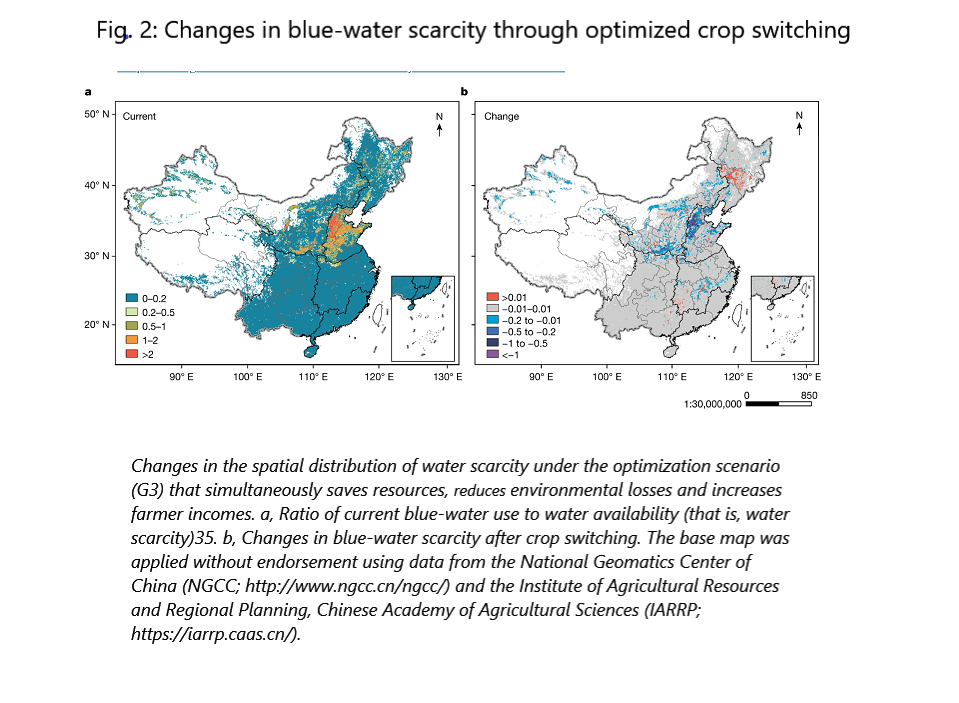
China enhances agricultural sustainability and farm incomes while maintaining national crop production on existing croplands though crop switching
The Green Revolution of the 1960s brought unprecedented increases in global food supply to meet a rapidly rising demand. However, the promotion of relatively few high-yielding crops and the accompanying input-intensive practices — such as fertilizers, pesticides, and irrigation — used to grow those crops has led to serious compromises for nutritional security and the environment. In China, a doubling of crop production since 1990 has seen related environmental issues similar to those brought on by the Green Revolution.
While China has made marked gains in its agricultural productivity in recent decades, these improvements have also brought mounting environmental challenges to the country, such as reduced groundwater levels, increasing agricultural greenhouse gas emissions, rising fertilizer intensity, and more widespread pesticide pollution.
A study published in Nature in March 2023, a team of agricultural scientists and economists from multiple institutions in China (and one from the US) reported that “crop switching” — changing the amount of farmland planted crops already grown in an area — can improve agricultural sustainability and farmer incomes without compromising food supply in China.
In order to reduce such challenges, China has introduced a series of policies and measures to improve agricultural sustainability. Although all of these solutions promise to reduce the environmental burden of agriculture, they tend to focus on singular outcomes and are based on the assumption that crops are already being grown in the locations in which they are best suited, in terms of climate and soils, and most resource-efficient.
The research team found that crop switching may offer promise for improving agricultural sustainability.
Field-based experiments in the North China Plain have shown that crop rotations alternative to conventional maize–wheat systems can reduce groundwater depletion and increase economic output. Whether and to what extent crop switching would yield similar benefits for agricultural sustainability more broadly across China still needs to be investigated.
The issue is of particular importance because efforts undertaken in China to improve its sustainable development goals will have far-reaching implications for addressing global food security and sustainability challenges — China alone accounts for large fractions of the global population, crop production, natural-resource use, cropland, and farmers.
The authors constructed a model combining high-resolution data on crop-specific yields, harvested areas, environmental footprints, and farmer incomes to quantify the current state of crop-production sustainability. They also performed spatial optimizations that redistributed crops to meet a suite of agricultural sustainable development targets.

Their findings show that crop switching is an important measure that can help achieve several sustainable development targets in China while improving farmer incomes and maintaining national crop production on existing croplands.
They also show that siloed efforts by individual Chinese government departments responsible for activities for certain sectors, such as agriculture, or specific natural resources, such as water, may lead to substantial tradeoffs for other sustainability outcomes and work as counter-productive purposes to the goals of other ministries. As such, coordination is essential for avoiding tradeoffs and, more desirably, realizing several co-benefits. For a country such as China with a large central planner government, such large-scale coordination is indeed feasible.
Further, because sustainability outcomes are dependent on location, their analysis can provide spatially detailed solutions for different areas of China based on local conditions and sustainability priorities. These spatially explicit quantifications can thus play an important role in evaluating where agricultural interventions — and which specific cropping switches — can offer the greatest benefits.
The research team’s study provides detailed, actionable scientific evidence as the Chinese government increases efforts to implement crop switching as a means of achieving more sustainable agriculture. The challenge of encouraging farmers to adopt new cropping choices is critical to realizing these changes. However, these changes are realistic and achievable, especially considering that China has had success in the past in incentivizing farmers to choose crops intended to achieve national food-security targets.
The spatially detailed results of the researchers’ analysis can directly meet the information needs described in recent government plans, which seek to address agricultural sustainability issues related to cultivated land, water resources, ecological protection, and national food production and food security.
These findings demonstrate the benefits of increased inter-ministry cooperation and are in line with recent plans by the Chinese government to strengthen coordination and enhance close cooperation among different agencies. The study’s quantitative assessment takes into account multiple aspects of sustainability and provides an objective, science-based foundation for ensuring the feasibility of potential solutions for more sustainable agricultural systems.
Original research paper:
Xie, W., Zhu, A., Ali, T. et al. ‘Crop switching can enhance environmental sustainability and farmer incomes in China’. Nature 616, 300–305 (2023). https://doi.org/10.1038/s41586-023-05799-x